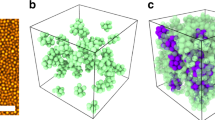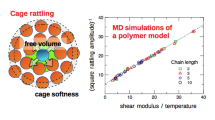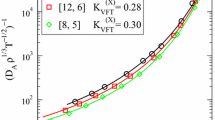Abstract.
The most puzzling aspect of the glass transition observed in laboratory is the decoupling of the dynamics from the structure. As an attempt to reconcile the dynamic and the static lengthscales associated with the glass problem, we discuss the apparent correlations between the static relaxation length, defined as that lengthscale over which the potential energy fluctuation is correlated, with the linear size of the dynamic heterogeneity. The dynamic heterogeneous domains with long life-times, may therefore be linked to the droplets of low potential energy, or the tightly bound regions inside the liquid.
Similar content being viewed by others
References
M.D. Ediger, C.A. Angell, S.R. Nagel, J. Phys. Chem. 100, 13200 (1996); C.A. Angel, Curr. Opin. Solid State Mater. Sci. 1, 578 (1996); P.G. Debenedetti, Metastable Liquids (Princeton University Press, Princeton, 1996)
C.A. Angell, J. Non-Cryst. Sol. 131-3, 13 (1991); 102, 205 (1988)
H. Vogel, Phys. Z. 22, 645 (1921); G.S. Fulcher, J. Am. Ceram. Soc. 8, 339 (1925)
W. Kauzmann, Chem. Rev. 43, 219 (1948); F.E. Simon, Z. Anorg. Algemein. Chem. 203, 217 (1931)
C.A. Angell, J. Res. Natl. Inst. Stand. Tech. 102, 171 (1997); R. Richert, C.A. Angell, J. Chem. Phys. 108, 9016 (1999)
M. Mezard, First steps in glass theory in More is different, edited by M.P. Ong, R.N. Bhatt (Princeton University Press, Princeton, 2001)
G. Adam, J.H. Gibbs, J. Chem. Phys. 43, 139 (1965)
J.H. Gibbs, E.A. DiMarzio, J. Chem. Phys. 28, 373 (1958)
T.R. Kirkpatrick, D. Thirumalai, P.G. Wolynes, Phys. Rev. A 40, 1045 (1989)
M.D. Ediger, Annu. Rev. Phys. Chem. 51, 99 (2000)
H. Sillescu, J. Non-Cryst. Solids 243, 81 (1999)
U. Tracht, M. Wilhelm, A. Heuer, H. Fang, K. Schmidt-Rohr, H.W. Spiess, Phys. Rev. Lett. 81, 2727 (1998)
E. Donth, J. Non-Cryst. Solids 53, 325 (1982)
E. Donth, H. Huth, M. Beiner, J. Phys.: Condens. Matter 13, 451 (2001)
L. Berthier, G. Biroli, J.-P. Bouchaud, L. Cipelletti, D. ElMasri, D. L'Hote, F. Ladieu, M. Pierno, Science 310, 1797 (2005)
J.S. Langer, Phys. Rev. Lett. 97, 115704 (2006); Phys. Rev. E 73, 041504 (2006)
S. Davatolhagh, J. Phys.: Condens. Matter 17, 1275 (2005)
H. Tanaka, J. Phys.: Condens. Matter 10, L207 (1998); H. Tanaka, J. Phys.: Condens. Matter 11, L159 (1999)
See also, H. Tanaka, J. Chem. Phys. 111, 3163 (1999); H. Tanaka, J. Chem. Phys. 111, 3175 (1999)
L.A. Fernandez, V. Martin-Mayor, P. Verrocchio, Phys. Rev. E 73, 020501 (2006)
G.S. Matharoo, M.S. Gulam Razul, P.H. Poole, Phys. Rev. E 74, 050502 (2006)
M. Goldstein, J. Chem. Phys. 51, 3728 (1969)
F.H. Stillinger, T.A. Weber, Phys. Rev. A 25, 978 (1982); Science 225, 983 (1984)
F.H. Stillinger, Science 267, 1935 (1995)
S. Buchner, A. Heuer, Phys. Rev. Lett. 84, 2168 (2000); Phys. Rev. E 60, 6507 (1999)
B. Doliwa, A. Heuer, Phys. Rev. Lett. 91, 235501 (2003); Phys. Rev. E 67, 031506 (2003)
A. Saksaengwijit, B. Doliwa, A. Heuer, J. Phys.: Condens. Matter 15, 1237 (2003)
S. Sastry, P.G. Debenedetti, F.H. Stillinger, T.B. Schroder, J.C. Dyre, S.C. Glotzer, Physica A 270, 301 (1999)
R.L. Leheny, N. Menon, S.R. Nagel, D.L. Price, K. Suzuya, P. Thiyagarajan, J. Chem. Phys. 105, 7783 (1996); A. van Blaaderen, P. Wiltzius, Science 270, 1177 (1995)
See, e.g., S. Davatolhagh, Am. J. Phys. 74, 441 (2006)
A. de Candia, A. Coniglio, Phys. Rev. E 65, 16132 (2001)
See, also, Fig. 3 in M. Campellone, B. Coluzzi, G. Parisi, Phys. Rev. B 58, 12081 (1998)
U. Mohanty, J. Chem. Phys. 100, 5905 (1994); Adv. Chem. Phys. 89, 89 (1994); A.B. Bestul, S.S. Chang, J. Chem. Phys. 40, 731 (1964)
An analogous, but long-range effect, arising from two-point density fluctuations is the cause of critical opalescence observed in fluids at their critical point. See, e.g., H.E. Stanley, Introduction to phase transitions and critical phenomena (Oxford University Press, Oxford, 1971)
Author information
Authors and Affiliations
Corresponding author
Rights and permissions
About this article
Cite this article
Davatolhagh, S. Apparent correlations between the static length of relaxation and the linear size of dynamic heterogeneity in fragile liquids. Eur. Phys. J. B 59, 291–295 (2007). https://doi.org/10.1140/epjb/e2007-00291-3
Received:
Published:
Issue Date:
DOI: https://doi.org/10.1140/epjb/e2007-00291-3




